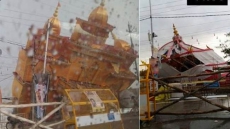When it embarked on its maiden epic journey of 2,496 km on June 1, 1912, Punjab Mail was the fastest train of undivided India and snaked its way from Mumbai (then Bombay) to Peshawar (now in Pakistan) in 47 hours.
Completing 104 years of its seemingly endless journey on Tuesday, the Punjab Mail -- 16 years older to the more glamorous Frontier Mail -- has been part of the Indian Railways history -- nay, the Indian sub-continent's history -- as it continues to traverse across several Indian states to transport countless passengers and goods.
On its maiden run from the now-defunct Ballard Pier Mole Station in Colaba on the southern tip of then Bombay, the Punjab Mail -- then known as The Punjab Limited -- chugged off with less than 100 passengers and a load of postal mail.
An 'elitist train' of the Central Railway network of its time, the Punjab Limited operated on fixed mail days to Peshawar from Bombay's Ballard Pier Mole Station, which served as a hub for the Great Indian Peninsular Railway built by the British.
It then had six cars -- three for a maximum of 96 passengers, and three for postal goods and mail.
Steamers of P&O, a British shipping and logistics company, brought in international mail, and officers of the British Raj along with their families and dogs on their first posting in Colonial India.
They sailed between Southampton in the United Kingdom to the Bombay port in ships in 13 days and since they held combined tickets for the sea voyage as well as train journey to their places of posting, they simply hopped on to one of the waiting trains bound for north (Delhi), east (Calcutta) or south (Madras).

So, the sparkling all-corridor cars with first class dual berth compartments, well appointed toilets, bathrooms, restaurant and a compartment for luggage and servants of the white 'sahibs' was a welcome break from the sea voyage for the officers of the British Raj as the train traversed through Itarsi, Agra, Delhi, Amritsar, Lahore and finally Peshawar Cantt.
The Punjab Limited -- later Punjab Mail -- started originating from and terminating at the Bombay Victoria Terminus, now called Chhatrapati Shivaji Terminus, when it was constructed in 1914.
Later, it began to cater to a larger clientele travelling in lower classes and Third Class cars in the mid-1930s.
Over a period of time, both the route of the train and the time it took underwent changes, apart from the stations it halted at during its journey and the types of engines used to haul it.
The first air-conditioned car was added to the train in 1945 and after the electrification of the Thull Ghats, it was hauled by electric engines from Bombay Victoria Terminus to Manmad (Nashik), and then onward pulled by WP class steam engines till Ferozepur in Punjab.
Currently, the Punjab Mail hauled by electric engines traverses the 1,930-km journey between Mumbai and Ferozepur Cantt in 34 hours.
Today, the train boasts of a First Class AC and AC 2-tier, One AC 2-tier, five AC 3-tier, 10 sleeper cars, three general second class coaches, two general second class-cum-guard's brake vans and a pantry car.

The Punjab Mail was a subject of a couple of eponymous movies released in 1939 and 1958, besides featuring in several stories and some Indian novels.




